
VOLKSWAGEN Jetta / Vento / Bora
Generations Timeline, Specs and Pictures
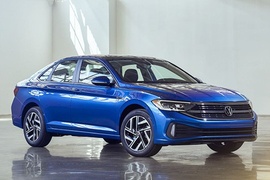
For three decades, the Jetta was the best-selling Volkswagen on the market, thanks to its compact size and three-box sedan look, which made it suitable for families and company cars as well.
In 2021, the German carmaker introduced a facelifted version for Jetta’s seventh generation, which modified the styling and some of the engines.
On the outside, the car featured a new grille with two distinctive chromed bars that flanked the VW logo in the middle. For the GLI version, a red strip ran across the bumper, connecting the standard LED headlights. From its sides, the chromed trims around the windows were another standard feature for the 2022 model year.
Inside, the German carmaker upgraded the infotainment system to the MIB3 version, fitted as standard for the GLI and available as an option for the rest of the range. Volkswagen also included an 8” display for the instrument cluster, with an option for a 10” unit dubbed Digital Cockpit Pro. As expected, the car featured wireless Android Auto and Apple CarPlay connectivity.
Under the hood, Volkswagen adopted the 1.5-liter turbocharged unit for most of the range. On the other hand, the GLI, provided the same 2.0-liter turbocharged powerplant as its predecessor. Depending on the options and version, an automatic (dual-clutch) transmission will be available for the entire range.

Volkswagen unveiled the second generation of the Chinese-specific Bora in 2007 at the Beijing Auto Show to increase its sales on that market.
The German carmaker considered the Chinese market a significant one since the ’80s. It started a joint-venture with First Automobile Works to assemble cars in the People’s Republic of China in 1988. Over time, the company developed and produced country-specific vehicles to fit the market’s needs and exceeded 780.000 sales in 2007. The second Bora generation was based on the same platform as the Golf IV and was adapted to the Chinese market.
At the front, the 2008 Bora showed a front fascia that resembled the EOS, with its headlights’ specific design. It was longer than the European or the U.S. cousins, thanks to its longer wheelbase. In the rear, the taillights looked closer to the Passat range than the Bora/Jetta siblings.
Inside, the car offered more legroom for the rear passengers and a dashboard design that looked closer to the Golf MKV than to the Golf MK IV. Another good point scored by Volkswagen was the trunk size, which was important for the Chinese market. It reached up to 450 liters (15.9 cu-ft), and its loading area could have been increased by folding down the rear bench seatback.
Under the hood, Volkswagen installed Euro4 gasoline engines paired as standard to a 5-speed manual. The carmakers offered an option for a 6-speed automatic transmission for the range-topper 2.0-liter version.
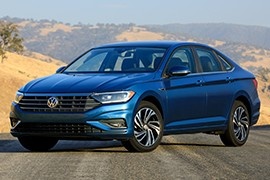
After selling more than 17 million Jetta/Bora/Vento models around the world, the seventh generation of the compact sedan from Volkswagen was introduced at the 2018 North American Auto Show.
It was the seventh generation for the Jetta and, as usual, it was based on the same platform as the Volkswagen Golf. That time, it was the MQB platform, which was also used for various vehicles from the German car manufacturer, including for compact and medium-sized SUVs.
The exterior looked similar to its larger brother, the Passat. The three horizontal chromed lines from the grille made the car look wider than it actually was. More additional lines like those were found in the lower part of the bumper. From the side, the Jetta featured another side window behind the rear doors, which was something unseen on this model before. In the back, the long taillights looked somehow similar to those found on an Audi A4 sedan.
The interior of the car was roomy enough for five adult passengers, with enough leg and headroom for the side passengers and limited foot space for the middle one. For the driver, there was a TFT display for the instrument cluster and a large 8” infotainment touch-screen on the same level with the steering-wheel, tilted toward the driver that was offered as an option. The standard unit was a 6.5” display. It was Android Auto and Apple CarPlay compatible.
From the technical point of view, depending on the engine, the Jetta featured a torsion beam suspension in the back and McPherson in the front. The base trim was offered with a standard 6-speed manual and an 8-speed automatic was optional. All the other trims got the latter one fitted as standard.

A cutdown version of the Volkswagen Passat, the Jetta was the best selling model in America.
For 2014, Volkswagen corrected some of the deficiencies the previous model had.
Available as a sedan or a 4-door wagon body style, the exterior design remained pretty much unchanged for 2014, however, the 2.5-liter unit was dropped.
A 1.8-liter 4-cylinder turbocharged engine replaced the 2.5-liter 5-cylinder engine, provided the same 170 hp as the older unit, however, offering more torque for better throttle response. Fuel economy was also improved with the new unit, mated with a 5-speed manual transmission or a 6-speed automatic gearbox.
One of the major updates was represented by the new sophisticated rear independent suspension that offered uncompromised control.
A hybrid version was also offered, developing the same power as the new 1.8-liter unit, however, the fuel consumption was impressive.
The performance choice in the Jetta line was represented by the top-of-the-range trim level, the GLI. It featured a 2.0-liter turbocharged 4-cylinder powerplant that developed 210 hp.
The design was also different, with sport trims inside and out and mechanicals were also improved with a stiffer suspension for better handling. The GLI featured red brake callipers.
While the Ford Focus and the Mazda 3 were strong competitors for the Jetta, neither of them could match the interior space the VW’s model offered.

Volkswagen introduced the sixth generation of the Jetta/Bora/Vento in 2010 and tried to convince the customers that it was a sporty compact sedan with four doors.
Like its predecessors, the Jetta/Bora/Vento was named according to customers’ preferences, depending on the market. It shared its platform with the VW Golf VI and sported independent suspension in all corners. But it wasn’t a true sport-sedan, like the Passat CC. It was just something more than a Golf with a trunk in the back.
On the outside, the Passat-like headlights with sharp lines and narrow, angular design showed more character than its Golf sibling. Its greenhouse was longer and sported a raked-forward rear windscreen. Just like its predecessors, the ascending beltline started on the headlights and went up all the way to the taillights.
Since it was built on a longer version of the Golf’s platform, inside it offered more room for the rear passengers. The carmaker installed vents on the back of the center console, so there was air-conditioning for the rear seat occupants as well. Volkswagen considered that installing a split-folding rear bench seatback would be a good idea for those who needed one. At the front, the Jetta came well equipped with an infotainment unit installed in the center stack.
Under the hood, Volkswagen installed a wide choice of engines ranged from a turbocharged 1.2-liter TSI all the way up to a 200 hp 2.0-liter TSI. In 2014, Volkswagen prepared a facelifted version that led to the dismissal of the 2.5-liter naturally aspirated engine.
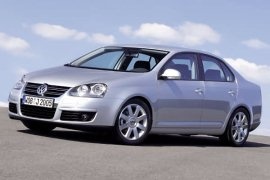
The Jetta reached its 5th generation when it was launched in 2005.
The first Jetta ever built saw the light in 1979.
The Jetta was unveiled at the Los Angeles Auto Show and with the new launch, Volkswagen decided to sell the model worldwide under
the nameplate of Jetta, rather than the different nameplates that were given for different market (Bora in Mexico, Sagitar in China and
Vento in Chile).
The exterior design was refreshed with the chrome radiator grille.
The Jetta was available with 3 trim levels: Trendline, Comfortline and Sportline. No base version was available for the model.
The 1.6-liter Trendline offered semi-automatic air conditioning, ESP, 6 airbags, active front head restraints, power windows, heated door mirrors and others.
The power of the engines mounted on the Jetta ranged from 102 hp to 200 hp. The available engines were 4 gasoline and 3 diesel options.
A sporty DSG double-clutch gearbox was available for the Diesel engines and the 2.0-liter gasoline.
Compared to the Bora, the Jetta was longer, wider and taller. The wheelbase was increased with 6,5 cm and the rear passengers would be the ones to enjoy the change, with more legroom available.
The new Jetta was equipped with standard LED taillights that provided better illumination.
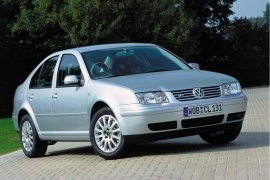
Volkswagen introduced the fourth generation of its compact sedan lineup in 1998 with different names for different markets, as Jetta, Bora or Vento, based on the same platform as the Golf MK4.
The German carmaker didn’t want to cause any confusion between models, so it drastically changed the car’s exterior, and, in the end, it didn’t even resemble the Golf. Its design department managed to create a completely new visual identity.
Even though it was introduced at the peak of the bio-design era, the Bora featured squared headlights and a conventional grille incorporated into the hood’s panel. Its greenhouse was as tall as the one on the Golf but with a sloped rear window instead of the vertical one, while the trunk line sat higher than the hood’s, creating a sportier appearance.
Inside, there was room for five adult passengers with a pair of regular seats at the front and very little side bolstering. In the back, the Jetta/Bora/Vento featured a flat bench suitable for three adults with adequate legroom and headroom but not very roomy. Its dashboard didn’t show any special design. It was bland but functional, with the stereo mounted on top of the climate control unit and a rounded instrument cluster that featured four analog dials and two LCDs inside the speedometer and tachometer.
The Jetta was available with a huge range of engines, but Volkswagen didn’t offer them on all the markets. Some were specific, such as the diesel and turbo-diesel versions, which were not very popular in the U.S. but on high-demand in Europe thanks to their fuel-efficiency. Volkswagen offered a few versions with an all-wheel-drive system.
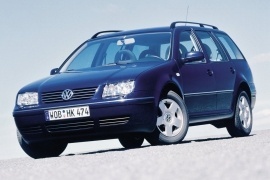
While it was already common for Volkswagen to offer a station wagon in its compact-segment, it was unusual to offer two vehicles based on the same platform with the same shape.
In 1997, Volkswagen introduced the Golf Variant. It was the first station wagon based on the successful Golf. Also, since the second Golf generation, Volkswagen offered it as a three-box sedan version named Vento. In 1999, the German carmaker had an unusual idea and changed the name from Vento to Bora and delivered it in a station-wagon shape. Its direct competitor was the Golf Variant.
Apart from the front fascia, there were very few differences between the two cars built by the same carmaker. To prevent direct competition, on some markets, Volkswagen offered only one of them. The Bora kept the same front fascia as its sedan sibling, with squared headlights. In the back, the car featured corner-mounted taillights and left a wide opening between the D-pillars for the tailgate.
Inside, there were some small differences between the Bora Variant and the Golf Variant. While the former was designed for families and tried to look more upmarket, the latter was still based on the same vehicle for the young generation.
Under the hood, Volkswagen installed a wide choice of engines ranging between a 115 hp 1.9-liter turbo-diesel engine and the VR6 top performer that sent 204 hp in all corners for the VR6 Syncro version.
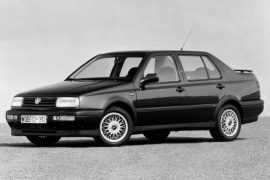
The 1992 version of Volkswagen Vento is actually the third generation of Volkswagen Jetta, a vehicle which was first manufactured by the German company in 1979.
Although it was already known as Jetta, Volkswagen decided to market the car model as Vento in Europe, but it continued to use the Jetta name in the North American market. In case you’re wondering where does the Vento name come from, find out that Vento actually means wind in Portuguese and Italian. This underlines the idea that Volkswagen attempted to gain the attention of the young consumers with this new model that already recorded an impressive success in the previous years of availability.























































